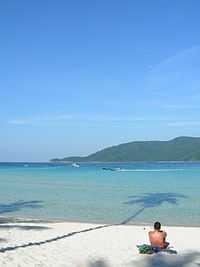Perhentian Islands

The Perhentian Islands (Pulau Perhentian in Malay) lie approximately 10 nautical miles (19 km) off the northeastern coast of West Malaysia in the state of Terengganu, approximately 40 miles (64 km) south of the Thai border.
The two main islands are Perhentian Besar ("Big Perhentian") and Perhentian Kecil ("Small Perhentian"). The small, uninhabited islands of Susu Dara (Virgin Milk), Serenggeh and Rawa lie off Kecil. The Perhentians belong to Pulau Redang National Marine Park, which means that fishing, collecting coral and littering are strictly prohibited. Like Besut, people here generally speak Kelantanese Malay.
History
The name "Perhentian" means "stopping point" in Malay, referring to the islands' traditional role as a waypoint for traders between Bangkok and Malaysia. The islands were sparsely inhabited by fishermen for centuries, although tourism now accounts for most economic activity.
The Perhentian Islands appear on many maps of the nineteenth and twentieth century as 'The Station Islands'. This arises from the British colonial period, as an English translation of "stopping point".
Pulau Perhentian was one of the islands where Vietnamese refugees or boat people landed during the 1970s.
Geography

Both islands are fringed by white sand beach, and the reefs and crystalline water are host to a wide variety of coral, sea-turtles, jellyfish, small sharks and reef-fish. The islands' maximum elevation is approximately 100 m (328 ft) and they are uniformly covered in coastal tropical jungle, with few interior foot-trails and no roads.
Other than the owners and staff of the numerous cabin-style resorts that dot the islands (many of whom depart for the monsoon season), the islands' only permanent inhabitants live in a small fishing village on Kecil. With the exception of a single mainland-communications tower on each island, there are no structures taller than two storeys.
Tourism

Nature tourism provides the economic base for the islands. Both the islands have palm-fringed white coral sand beaches (that can be tough on the feet) and turquoise blue sea. Popular tourist activities include scuba-diving, snorkeling, and swimming. On most beaches, the water is shallow with many rays, cuttlefish and parrotfish. For diving, there are dozens of divesites around both main islands, as well as several off-shore sites. Apart from these, activities like camping, canoeing, fishing, jungle trekking, and banana boat riding are also available. As for accommodation, most of it can be found on Perhentian Besar, the larger island. Hotels are usually aimed at budget travelers.

The only access to the Islands is by boat from the fishing villages of Kuala Besut and Tok Bali. Local tourist operators run fishing boats and speed boats several times a day. Most travellers get into region by AirAsia from Kuala Lumpur (flight to Kota Bharu) or from Bangkok (flight to Narathiwat)
Electricity
In the summer of 2007, two wind turbines were installed, although they were still not connected to the network as of August 2013, leaving diesel generators as the main source of the islands' electrical power. A third turbine is being built. Electricity is available 24-hours during high season. Fresh water is provided by springs.
Turtle conservation
The Perhentian Islands were once home to a significant green and hawksbill sea turtle nesting population. Now the islands receive only 300 nestings per year, partly due to frequent oil spills from nearby oil production platforms and oil tankers owned by Petronas. The Department of Fisheries runs a turtle hatchery on the islands to help address the declining turtle populations. Egg poaching from the beaches is a continuing problem.
External links
 Perhentian Islands travel guide from Wikivoyage
Perhentian Islands travel guide from Wikivoyage- Perhentian Islands Tourism Information Official Website
| ||||||||||||||||||||
| ||||||||||||||
Coordinates: 5°55′N 102°44′E / 5.917°N 102.733°E